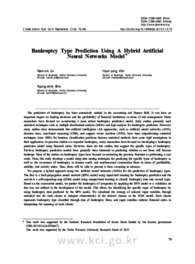

PARTNER
검증된 파트너 제휴사 자료
Bankruptcy Type Prediction Using A Hybrid Artificial Neural Networks Model
한국학술지에서 제공하는 국내 최고 수준의 학술 데이터베이스를 통해 다양한 논문과 학술지 정보를 만나보세요.
21 페이지
최초등록일 2025.04.28
최종저작일
2015.09

-
미리보기
서지정보
· 발행기관 : 한국지능정보시스템학회
· 수록지 정보 : 지능정보연구 / 21권 / 3호 / 79 ~ 99페이지
· 저자명 : 조남옥, 김현정, 신경식
초록
The prediction of bankruptcy has been extensively studied in the accounting and finance field. It can have an important impact on lending decisions and the profitability of financial institutions in terms of risk management. Many researchers have focused on constructing a more robust bankruptcy prediction model. Early studies primarily used statistical techniques such as multiple discriminant analysis (MDA) and logit analysis for bankruptcy prediction. However, many studies have demonstrated that artificial intelligence (AI) approaches, such as artificial neural networks (ANN), decision trees, case-based reasoning (CBR), and support vector machine (SVM), have been outperforming statistical techniques since 1990s for business classification problems because statistical methods have some rigid assumptions in their application. In previous studies on corporate bankruptcy, many researchers have focused on developing a bankruptcy prediction model using financial ratios. However, there are few studies that suggest the specific types of bankruptcy. Previous bankruptcy prediction models have generally been interested in predicting whether or not firms will become bankrupt. Most of the studies on bankruptcy types have focused on reviewing the previous literature or performing a case study. Thus, this study develops a model using data mining techniques for predicting the specific types of bankruptcy as well as the occurrence of bankruptcy in Korean small- and medium-sized construction firms in terms of profitability, stability, and activity index. Thus, firms will be able to prevent it from occurring in advance.
We propose a hybrid approach using two artificial neural networks (ANNs) for the prediction of bankruptcy types. The first is a back-propagation neural network (BPN) model using supervised learning for bankruptcy prediction and the second is a self-organizing map (SOM) model using unsupervised learning to classify bankruptcy data into several types. Based on the constructed model, we predict the bankruptcy of companies by applying the BPN model to a validation set that was not utilized in the development of the model. This allows for identifying the specific types of bankruptcy by using bankruptcy data predicted by the BPN model. We calculated the average of selected input variables through statistical test for each cluster to interpret characteristics of the derived clusters in the SOM model. Each cluster represents bankruptcy type classified through data of bankruptcy firms, and input variables indicate financial ratios in interpreting the meaning of each cluster.
The experimental result shows that each of five bankruptcy types has different characteristics according to financial ratios. Type 1 (severe bankruptcy) has inferior financial statements except for EBITDA (earnings before interest, taxes, depreciation, and amortization) to sales based on the clustering results. Type 2 (lack of stability) has a low quick ratio, low stockholder’s equity to total assets, and high total borrowings to total assets. Type 3 (lack of activity) has a slightly low total asset turnover and fixed asset turnover. Type 4 (lack of profitability) has low retained earnings to total assets and EBITDA to sales which represent the indices of profitability. Type 5 (recoverable bankruptcy) includes firms that have a relatively good financial condition as compared to other bankruptcy types even though they are bankrupt. Based on the findings, researchers and practitioners engaged in the credit evaluation field can obtain more useful information about the types of corporate bankruptcy.
In this paper, we utilized the financial ratios of firms to classify bankruptcy types. It is important to select the input variables that correctly predict bankruptcy and meaningfully classify the type of bankruptcy. In a further study, we will include non-financial factors such as size, industry, and age of the firms. Thus, we can obtain realistic clustering results for bankruptcy types by combining qualitative factors and reflecting the domain knowledge of experts.참고자료
· 없음태그
-
자주묻는질문의 답변을 확인해 주세요

꼭 알아주세요
-
자료의 정보 및 내용의 진실성에 대하여 해피캠퍼스는 보증하지 않으며, 해당 정보 및 게시물 저작권과 기타 법적 책임은 자료 등록자에게 있습니다.
자료 및 게시물 내용의 불법적 이용, 무단 전재∙배포는 금지되어 있습니다.
저작권침해, 명예훼손 등 분쟁 요소 발견 시 고객센터의 저작권침해 신고센터를 이용해 주시기 바랍니다. -
해피캠퍼스는 구매자와 판매자 모두가 만족하는 서비스가 되도록 노력하고 있으며, 아래의 4가지 자료환불 조건을 꼭 확인해주시기 바랍니다.
파일오류 중복자료 저작권 없음 설명과 실제 내용 불일치 파일의 다운로드가 제대로 되지 않거나 파일형식에 맞는 프로그램으로 정상 작동하지 않는 경우 다른 자료와 70% 이상 내용이 일치하는 경우 (중복임을 확인할 수 있는 근거 필요함) 인터넷의 다른 사이트, 연구기관, 학교, 서적 등의 자료를 도용한 경우 자료의 설명과 실제 자료의 내용이 일치하지 않는 경우
“지능정보연구”의 다른 논문도 확인해 보세요!
-
특허의 기술이전 활성화를 위한 소셜 태깅기반 지적재산권 추천플랫폼 25 페이지
국내에서 출원되는 특허건수는 매년 증가하고 있으나, 이러한 특허들 중 상당수는 활용되지 못하고 사장되고 있다. 2012년 국정감사 자료에 따르면, 우리나라 대학 및 공공연구기관이 보유한 특허의 약 73%가 사회적 가치창출로 연결되지 못하는 휴면특허라고 한다. 즉, 대학/연구소 또는 사업화가 어려운 개인이 소유하고 있는 특허가, 이를 필요로 하는 수요기업에 .. -
일반영향요인과 댓글기반 콘텐츠 네트워크 분석을 통합한 유튜브(Youtube)상의 콘텐츠 확산 영향요인 연구 18 페이지
대표적 소셜미디어인 유튜브는 기존 폐쇄형 콘텐츠 서비스와는 다르게 개방형 콘텐츠 서비스로 이용자들의 참여와 공유를 통하여 많은 인기를 유지하고 있다. 콘텐츠 산업에서 중요한 위치를 차지하고 있는 유투브 상의 콘텐츠 확산 요인에 관한 기존의 연구들은 댓글 수 등과 같은 일반적 정보 특성 요인과 조회 수 간에 상관관계 등을 분석하는 것이 대부분이었다. 최근 네..
문서 초안을 생성해주는 EasyAI
